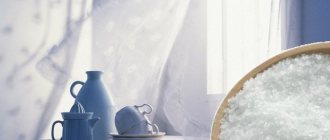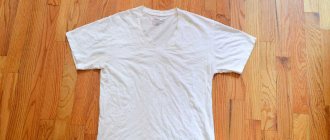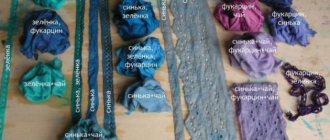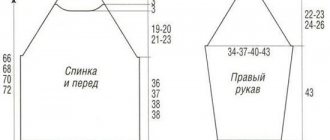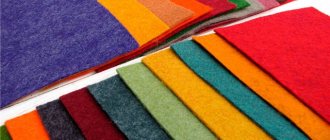White clothes get dirty faster because... The slightest dirt is visible on it. Moreover, washing alone is often not enough. For this reason, auxiliary methods are used that will help clean white products from old stains and also return them to their original color.
When choosing, you should take into account the composition and properties of the fabric. For example, wool products are more demanding to care for. Using unsuitable bleaches will have the opposite effect: stains will appear and the material will turn yellow. When choosing a method for bleaching wool or synthetics, consider using homemade and chemical compounds.
Features of whitening
When washing clothes made from different materials, a number of rules are taken as a basis. They are suitable for wool and synthetics. If the sweater is white, you can maintain and restore the color using chemicals. But the rules must be followed:
- liquid temperature: +30°…40°С;
- a white item of clothing (sweater, jacket) will turn gray if you regularly wash it in a container made of metal with chrome, so it is better to choose other dishes: with an enamel coating, ceramic, plastic;
- in order not to spoil the material using untested components, first apply a minimal amount to a white sweater from the wrong side (along the edge), if the appearance does not change after a few minutes, begin bleaching;
- return the original color to a light-colored item when washed by hand and in a washing machine (the label on the clothing is first examined).
You can restore the color of a wool or synthetic product using bleaches, provided that it has been washed beforehand.
How not to ruin a white woolen item
In order not to spoil a white wool product when bleaching, you must adhere to the following recommendations:
- When purchasing bleach, pay attention to the type of fibers for which it is intended (wool and silk);
- follow the instructions for use of the product;
- rinse the knitted item thoroughly to get rid of any remaining bleaching solution and detergents;
- to avoid shrinkage, maintain the same temperature of water for soaking, washing and rinsing;
- you need to wring out the product through a light-colored terry towel, gathering the knitted fabric into a ball or rolling it with a roller (not tightly);
- dry away from direct sunlight and heat sources (battery, radiator, etc.) to prevent yellow stripes and spots from appearing;
- to dry, lay out on a flat surface, covering it with a terry towel or flannel diaper (preferably white);
- When applying the brightening solution to problem areas, use a cotton pad or swabs;
- place a piece of old clean cloth under the treated area to absorb contaminated liquid so that yellowness does not appear on other parts of the product;
- If possible, avoid excessively long soaking and high temperatures (over +40°C).
If you are unable to purchase a special wool bleach, you should not use products containing chlorine. This aggressive substance changes the structure of the fibers, they will become hard and brittle, and the product itself will be prickly, losing elasticity and strength. Some varieties of wool yarn, after being treated with chlorine-containing solutions, acquire an unpleasant dirty yellow tint.
When planning to boil a knitted product, you should take into account that it may mat and irreversibly lose its shape. This procedure is more suitable for lightening wool yarn or an old item, which they then plan to unravel and knit something new.
By following the recommendations and paying attention to precautions, you can return the whiteness to your favorite blouse or jumper, add freshness to snow-white hats and scarves, and then your favorite things will delight their owners for a long time.
Mistakes and tips for caring for sweaters made from natural materials
White pullovers quickly lose their shape, their appearance deteriorates if the basic rules are not followed:
- It happens that the jacket is wrung out or twisted, but this cannot be done. The drops should be allowed to drain, then you can lay out the woolen item on a horizontal surface.
- Powders are used, which causes the fabric to become stiff. It is better to use liquid formulations.
- Woolen items are soaked for a long time, which causes the fibers to stretch. The contact time of products with liquid should be limited.
- When washing in a machine, you need to choose gentle modes (manual, delicate, for wool).
Machine washable
When bleaching woolen items during washing in an automatic machine, it is important to follow the following recommendations:
- use detergents for wool products;
- the amount of special bleach should not exceed the amount recommended in the instructions;
- washing temperature no more than 40°C;
- set the spin to the lowest speed;
- do not use machine drying.
Help: If you soak woolen items for 15 minutes in a soda solution (50 grams of soda per 5 liters of water) before washing, then you will not have to wash them additionally.
How to bleach
Considering ways:
- washing with powder containing bleaching crystals: such components are used to preserve the original color of the product, but if the jacket is heavily soiled, it will not be possible to restore it;
- the use of special bleaching compounds (for wool or synthetics, there are also universal types): they are used after washing, a white sweater is usually completely soaked or dirt is removed pointwise;
- folk recipes.
If you need to bleach a wool sweater, it is not recommended to use chlorine-containing compounds, as they cause the fabric to yellow.
Soda
If you don't have hydrogen peroxide on hand, you can use baking soda or soda ash. The solution is prepared in a similar way:
- dissolve baking soda in cool water;
- lower the sweater;
- We wait a couple of hours.
During this time, the wool will begin to bleach right before your eyes. We take out the item and rinse it in running water.
With this product you can provide ongoing care. To do this, add a little baking soda when washing. It softens water and neutralizes salts that negatively affect the condition of the coat.
Chemical bleaches
White items are often washed using special compounds. It is recommended to choose modern substances; they are designed taking into account the properties of the fabric and allow you to carefully bleach the sweater. They are used as needed. You should choose a bleach for wool, cotton or synthetics, paying attention to the composition and purpose.
In addition, such funds are divided into groups, taking into account differences in the principle of action:
- optical: create the effect of lightening the material, in fact the composition includes masking granules, a gray coating remains on the fabric;
- oxygen - the most common, contain sodium percarbonate, which provides surface oxidation.
Available options:
- Bos plus OXI. A white sweater is soaked for 30-40 minutes (60 g of powder per 2 liters of water).
- Sodacan. You can bleach a sweater in a washing machine. An alternative option is soaking. Prepare a solution (1 tablespoon of substance per 3 liters of liquid). Whitening duration is no more than 30 minutes. Sodacan is suitable for clothes made from yarn.
- Vanish Oxi Action. First, the white pullover is soaked (the duration depends on the type of product). The solution is prepared taking into account the proportions: bleach for woolen wardrobe items or clothing made from other materials - 1 cap, water - 4 liters.
- Swan. Contains oxygen granules, they are activated in water. To bleach wool or cotton, the material is immersed in a substance.
- Persol. Oxygen bleach also contains optical components. As a result, the white sweater is not only cleaned of dirt, but also returns to its original whiteness.
Special means
For those who don’t want to bother with preparing homemade mixtures, ready-made industrial bleaches are sold: chlorine-containing, oxygen-containing and optical. The principle of their operation has its own characteristic differences:
- Chlorine-containing compounds are considered very effective, but aggressive. Not every material can survive such a strong impact.
- Oxygen-containing products are gentler. They are indispensable if you need to restore the whiteness of things with colored inserts.
- Optical brighteners do not remove dark plaque, but mask it using special granules that envelop the fabric fibers.
The most famous brands are Vanish, Persol, Belizna, Amway, Help and Faberlic. Whatever product you choose, be sure to read the instructions on the label before using it.
Another important rule for all types of bleaches: under no circumstances leave the composition on woolen material longer than it should be. This may damage the fabric.
Might be interesting
- Rules and methods for bleaching the collar of a dark dress Fashion designers and style experts believe that every woman should have a little black dress in her wardrobe...
- Rules for cleaning faux fur products To ensure that items made from this material serve you as long as possible, it is important to know how to clean faux fur…
- Dyeing products made from arctic fox fur: tips and rules Often, owners of expensive fur products need to dye arctic fox fur at home. Fur coats,…
Folk recipes
Choose an option taking into account the properties of the fabric. Moreover, not all recipes are suitable for woolen clothes.
Soda
This is a universal method. With its help, you can keep a white woolen sweater, as well as clothes made from other materials, from yellowing.
Use the soaking method: 2 tbsp. l. soda, 1 liter of liquid. The sweater is left for half an hour, then it needs to be rinsed. It is not recommended to add powder or soap.
The disadvantage of this method is its low efficiency: soda will not remove complex stains from cotton and woolen items at home.
Laundry soap
This method is based on exposure to boiling water. This means that it cannot be used to bleach a wool pullover.
Instructions:
- Mix shavings of laundry soap with water.
- Heat the liquid. They put down a white sweater that needs cleaning.
- After 10 minutes, remove the container from the stove.
- The sweater needs to be rinsed.
- Then put the clothes in a vinegar-based solution: 5-6 tbsp. l. substances, 3-4 liters of water. After 5 minutes you can rinse.
Salt
If you are choosing a way to bleach white woolen items, consider this option. Salt acts gently and removes light stains. The effect is noticeable after several uses.
You need to prepare a solution: 5 liters of liquid, 200 g of water. A sweater made of yarn must be immersed and removed from it. The procedure is repeated up to 5 times. Periodically leave the sweater for 3-5 minutes in the same solution, then allow the water to drain. There is no need to rinse clothes.
Hydrogen peroxide
This option is universal. It is used even if a method is chosen not only to bleach woolen items, but also items of a different composition that require care.
You can restore the properties of fabric at home by soaking the clothes in a bucket of water to which 2-3 bottles of peroxide have previously been added. The duration of the procedure is 2 hours.
You cannot dry a sweater on newspaper or colored surfaces - the paint will transfer to the sweater.
Sodium hyposulfite
Release form: powder. It is a reducing agent and is used in medicine and industry. You need to look for sodium hyposulfite in a pharmacy.
The solution is prepared as follows: add the powder (the contents of the package) into a basin filled with water and dissolve it. To bleach a sweater, you need to soak it in the product for 2 hours. Then the product is rinsed in water.
Chalk
To whiten the product you will need 500 g of chalk. It is poured into a basin of water. The fractions do not dissolve, so the liquid is constantly stirred. The jacket is left in the container with the solution for 1 hour, then it needs to be rinsed.
Lemon acid
White things are restored using a solution: add 5 tbsp to the liquid (5 l). l. citric acid. When the fractions dissolve, immerse the contaminated items in the container. The duration of soaking is always different, depending on the type of fabric and the complexity of the stains. The average duration of the procedure is 6-8 hours.
Tip: White things need to be constantly turned over. This will ensure an even effect of the product.
Ammonia
This is the most effective home method.
Instructions for use:
- Solution recipe: 6 liters of water, 10 ml of ammonia.
- Soaking duration is 10 minutes. At this time, prepare another remedy: 5 ml of peroxide, 1 ml of ammonia, no more than 1000 ml of water.
- Things are transferred from the first container to the second.
- After half an hour, add vinegar (2 tsp). Stir, then take out the white things.
- After rinsing, they are hung out.
Chalk
Chalk is a good way to whiten a white sweater at home. One voluminous sweater for an adult will require approximately half a kilogram of crushed chalk:
- Grind the chalk to flour and pour it into a basin.
- Pour warm water over the powder and stir.
- Place a woolen hat or scarf in the white mixture and leave for one hour.
Chalk does not dissolve in water and settles at the bottom of the container, so it is necessary to stir the solution every 10 minutes. After finishing the bleaching procedure, drain the chalk liquid and rinse the yarn.
How to properly bleach skeins of wool yarn
Use white threads to tie the skeins. The yarn is soaked in the selected solution for half an hour (folk remedies or chemical compounds are used). Then it is rinsed in a vinegar solution.
For severe yellowing, use another method:
- bucket with water;
- office glue - 1/10 of the weight of a skein of wool;
- 2 tbsp. l. soda;
- peroxide - 1/3 of the weight of the skein.
Whitening wool using this recipe lasts up to 3 hours.
Removing stains
For any synthetics, except acetate fabrics, the following mixture is used to remove stains: 5 parts alcohol, 5 parts tartaric acid, 2 parts citric acid. The result of mixing should be a paste. It is applied to the stain and rubbed in 5-10 minutes before washing.
A few more recommendations for removing stains from light-colored synthetics.
- Sweat stains can be washed off if 2 aspirin tablets are crushed and dissolved in 100 ml of cold water, and the resulting solution is applied to the contaminated areas 2-3 hours before washing.
- Grease stains are removed with salt or chalk. Chalk powder or salt is rubbed into the stain, and after a few hours it is removed with a brush. This method is only suitable for fresh stains.
- Ink stains are removed by soaking and washing the stained area in fresh milk or curdled milk.
- You can try to remove the resulting rust stain with lemon. A lemon wrapped in gauze is applied to the stain and pressed with an iron.
Useful tips
To keep wool fiber products in excellent condition, follow these tips:
- If wool clothing has turned yellow over time, boil it with soap. You will need to pour shavings from laundry soap into the water. After boiling, be sure to rinse, do this several times, gradually lowering the temperature. During the final rinse, add vinegar to the water;
- ammonia, which is sold in pharmacies, contains ammonia in its composition. And it can bleach wool very well;
- Knitted clothes are washed only with special detergents.
What does the industry offer?
We have already talked about one industrial bleach, “Whiteness”. But the modern range of household chemicals is so diverse that it allows you to choose other bleaching products.
When purchasing, make sure that the package is marked “For wool”, otherwise you may fail.
Note! For woolen items, neither powders nor bleaches with biological additives that destroy protein compounds should be used. The protein in the fabric will suffer in the same way as the stains, and the fabric will deteriorate.
Choosing the expensive “Vanish Oxy” or the classic “Swan” is a matter entirely dependent on your preferences and budget. Try it, experiment, share your feedback.



